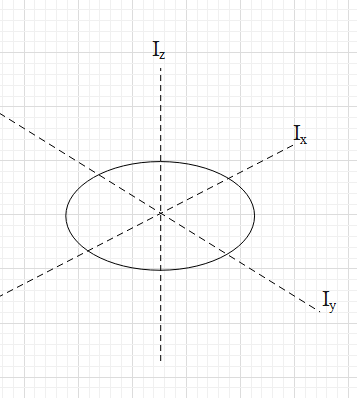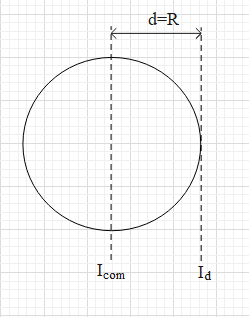
The moment of inertia of a circular ring is about an axis perpendicular to its plane and passing through its centre. About an axis passing through tangent of ring in its plane, its moment of inertia is:
$\text{A}\text{. }\dfrac{I}{2}$
$\text{B}\text{. }\dfrac{2I}{3}$
$\text{C}\text{. }\dfrac{3I}{2}$
$\text{D}\text{. }\dfrac{I}{3}$
Answer
512.7k+ views
Hint: Use the perpendicular axis theorem and find the moment of the ring about an axis in the plane of the ring passing through its centre. Then use the parallel axis theorem to find its moment of inertia about an axis passing through the tangent of the ring in its plane.
Formula used:
${{I}_{z}}={{I}_{x}}+{{I}_{y}}$
${{I}_{d}}={{I}_{com}}+M{{d}^{2}}$
Complete answer:
The moment of inertia of a circular ring about an axis perpendicular to its plane passing through its centre is equal to $M{{R}^{2}}$, where M is the mass of the ring and R is the radius of the ring.
Hence, $I=M{{R}^{2}}$.
To find the moment of inertia of the ring about an axis that is tangent to the ring in the plane of the ring, let us use the theorems of perpendicular axis and parallel axis.
Let us first use the perpendicular theorem. Perpendicular axis theorem gives the value of moment of inertia about an axis perpendicular to a plane (${{I}_{z}}$) in in terms of moment of inertias about two perpendicular axes (${{I}_{x}}$ and ${{I}_{y}}$) lying in the plane and intersecting at the centre.

i.e. ${{I}_{z}}={{I}_{x}}+{{I}_{y}}$…. (i).
In this case, ${{I}_{z}}=I=M{{R}^{2}}$.
Due to symmetry of the ring, the moment of inertia about two perpendicular axes in its plane will be the same. Let they be equal to I’.
Hence, ${{I}_{x}}={{I}_{y}}=I'$.
Substitute the values of all three moments of inertia in equation (i).
$M{{R}^{2}}=I'+I'=2I$
$\Rightarrow I'=\dfrac{M{{R}^{2}}}{2}$
This means that the moment of inertia of the ring about an axis passing through its centre and lying in its plane is equal to $\dfrac{M{{R}^{2}}}{2}$.
Now, let us use the parallel axis theorem. This theorem gives the moment of inertia about an axis parallel to an axis passing through the centre of mass.

According to this theorem, ${{I}_{d}}={{I}_{com}}+M{{d}^{2}}$.
Here, ${{I}_{com}}$ is moment of inertia about an axis passing through its centre of mass, ${{I}_{d}}$ is moment of inertia about the axis parallel to the axis passing through centre of mass and d is the perpendicular distance between the two axes.
In this case, ${{I}_{com}}=I'=\dfrac{M{{R}^{2}}}{2}$ and d=R. ${{I}_{d}}$ is moment of inertia about an axis tangent to the ring.
Therefore, ${{I}_{d}}=\dfrac{M{{R}^{2}}}{2}+M{{R}^{2}}=\dfrac{3M{{R}^{2}}}{2}=\dfrac{3I}{2}$
So, the correct answer is “Option C.
Note:
Note that the perpendicular axis theorem is applicable for planar bodies only. We call planar bodies as two-dimensional bodies. If we have a three-dimensional body, then we use a parallel axis theorem for it but we cannot apply the perpendicular axis theorem.
Formula used:
${{I}_{z}}={{I}_{x}}+{{I}_{y}}$
${{I}_{d}}={{I}_{com}}+M{{d}^{2}}$
Complete answer:
The moment of inertia of a circular ring about an axis perpendicular to its plane passing through its centre is equal to $M{{R}^{2}}$, where M is the mass of the ring and R is the radius of the ring.
Hence, $I=M{{R}^{2}}$.
To find the moment of inertia of the ring about an axis that is tangent to the ring in the plane of the ring, let us use the theorems of perpendicular axis and parallel axis.
Let us first use the perpendicular theorem. Perpendicular axis theorem gives the value of moment of inertia about an axis perpendicular to a plane (${{I}_{z}}$) in in terms of moment of inertias about two perpendicular axes (${{I}_{x}}$ and ${{I}_{y}}$) lying in the plane and intersecting at the centre.

i.e. ${{I}_{z}}={{I}_{x}}+{{I}_{y}}$…. (i).
In this case, ${{I}_{z}}=I=M{{R}^{2}}$.
Due to symmetry of the ring, the moment of inertia about two perpendicular axes in its plane will be the same. Let they be equal to I’.
Hence, ${{I}_{x}}={{I}_{y}}=I'$.
Substitute the values of all three moments of inertia in equation (i).
$M{{R}^{2}}=I'+I'=2I$
$\Rightarrow I'=\dfrac{M{{R}^{2}}}{2}$
This means that the moment of inertia of the ring about an axis passing through its centre and lying in its plane is equal to $\dfrac{M{{R}^{2}}}{2}$.
Now, let us use the parallel axis theorem. This theorem gives the moment of inertia about an axis parallel to an axis passing through the centre of mass.

According to this theorem, ${{I}_{d}}={{I}_{com}}+M{{d}^{2}}$.
Here, ${{I}_{com}}$ is moment of inertia about an axis passing through its centre of mass, ${{I}_{d}}$ is moment of inertia about the axis parallel to the axis passing through centre of mass and d is the perpendicular distance between the two axes.
In this case, ${{I}_{com}}=I'=\dfrac{M{{R}^{2}}}{2}$ and d=R. ${{I}_{d}}$ is moment of inertia about an axis tangent to the ring.
Therefore, ${{I}_{d}}=\dfrac{M{{R}^{2}}}{2}+M{{R}^{2}}=\dfrac{3M{{R}^{2}}}{2}=\dfrac{3I}{2}$
So, the correct answer is “Option C.
Note:
Note that the perpendicular axis theorem is applicable for planar bodies only. We call planar bodies as two-dimensional bodies. If we have a three-dimensional body, then we use a parallel axis theorem for it but we cannot apply the perpendicular axis theorem.
Recently Updated Pages
Master Class 11 Economics: Engaging Questions & Answers for Success

Master Class 11 English: Engaging Questions & Answers for Success

Master Class 11 Social Science: Engaging Questions & Answers for Success

Master Class 11 Biology: Engaging Questions & Answers for Success

Class 11 Question and Answer - Your Ultimate Solutions Guide

Master Class 11 Business Studies: Engaging Questions & Answers for Success

Trending doubts
What is meant by exothermic and endothermic reactions class 11 chemistry CBSE

10 examples of friction in our daily life

One Metric ton is equal to kg A 10000 B 1000 C 100 class 11 physics CBSE

Difference Between Prokaryotic Cells and Eukaryotic Cells

What are Quantum numbers Explain the quantum number class 11 chemistry CBSE

1 Quintal is equal to a 110 kg b 10 kg c 100kg d 1000 class 11 physics CBSE




